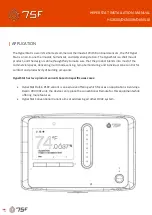
~
1
2
BK WH
1
2
3
4
5
6
VT RD WH OG PK GY
Tf1
Tf2
Tf3 LED
<5°
<85°
C
ommon
NC
NO
C
ommon
NC
NO
THERMAL
FUSE
Damper
Closed
Damper
Open
PM24-TF
~
N
L
1
2
BU BN
PM230-TF
Connections
shown with no
po
w
er to actuator
BSB PM24-TF & BSB PM230-TF
ELECTRICAL CONNECTIONS
DAMPER ENERGISED OPEN / SPRING CLOSED OPTION
• Wiring diagram shows switch positions based on no power to actuator
• Damper required normally open
• Spring close on removal of power or thermal fuse activation
24V AC/DC:
Connect via safety isolation transformer
230V AC:
For disconnection from the supply, a separate
device must be incorporated in the fixed wiring
(at least 3mm contact gap in all poles)
For damper closed indication use terminals 1 & 2
For damper open indication use terminals 4 & 6
Terminals 1 & 4 can be linked where required as an option
Unused cores should be isolated
Connecting cables need to be protected from sharp edges
22.
Commissioning
22.1 The damper cannot be commissioned unless it is fully installed and connected to mains power in
compliance with regulations.
22.2 Dampers should be fully inspected and checked in accordance with the inspection handover check
sheet prior to the dampers and panel being commissioned.
22.3 Electro-mechanically operated dampers can be tested/commissioned by a locally appointed, competent
person.
22.4 The installation needs to be inspected thoroughly, before the damper actuation is tested.
22.5 Actuation testing should be completed as follows:
22.5.1 Isolate the power.
22.5.2 Remove access door(s).
22.5.3 Test manually, using the crank handle provided, to set the damper to the 'normal state'
(powered state). A quarter turn in the opposite direction locks it. Visually confirm that
the damper is in its 'normal state'.
22.5.4 Release the motor if it is locked by turning the crank handle a quarter turn in the
winding direction and allow the damper to travel to 'fail-safe' position.
22.5.5 Visually confirm that the damper is in the correct position.
22.5.6 Switch on power to actuator. LED on TF (where present) will illuminate. The actuator
will start to travel to the DRIVE-END (normal state) position, reaching it within 60
seconds, visually check that the damper blade-position and signal corresponds.
22.5.7
IMPORTANT:
Press and hold test switch lever on TF to allow to allow actuator to travel
to its SPRING END position. Visually check that the damper blade position and signal
corresponds. (This is to ensure that the actuator functions electrically and overrides
the manual reset facility -should it have been used-, as it is feasible to leave the
damper inadvertently reset without the TF being functional if this test is not carried out!)
22.6 Ensure the damper is left in its 'normal state' (powered) before re-fitting access doors.
23.
Electrical Connections
FSD-TD - Installation Operation and Maintenance Instructions
Page 18





















